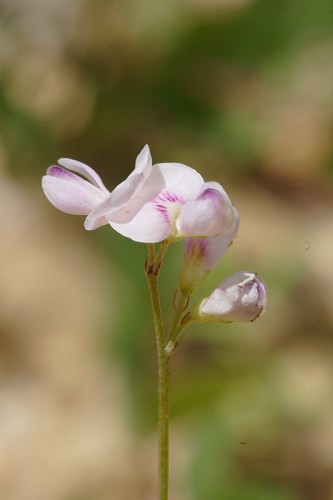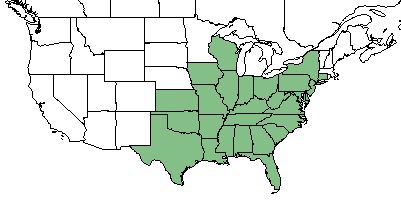Difference between revisions of "Lespedeza repens"
| Line 37: | Line 37: | ||
<!--===Seed dispersal===--> | <!--===Seed dispersal===--> | ||
<!--===Seed bank and germination===--> | <!--===Seed bank and germination===--> | ||
| − | + | ||
| − | <!--===Pollination===--> | + | ===Fire ecology=== <!--Fire tolerance, fire dependence, adaptive fire responses--> |
| + | ''L. repens'' may require fire to maintain higher frequencies. On the Florida panhandle sandhills, its frequency was 25 in 1966. After 57 years of not burning, the frequency dropped to 4.<ref name="Clewell 2014">Clewell AF (2014) | ||
| + | Forest development 44 years after fire exclusion in formerly annually burned oldfield pine woodland, Florida. Castanea 79(3):147-167.</ref> | ||
| + | <!--===Pollination===--> | ||
===Use by animals=== <!--Herbivory, granivory, insect hosting, etc.--> | ===Use by animals=== <!--Herbivory, granivory, insect hosting, etc.--> | ||
Revision as of 21:01, 12 February 2018
| Lespedeza repens | |
|---|---|

| |
| Photo by the Southeastern Flora Database | |
| Scientific classification | |
| Kingdom: | Plantae |
| Division: | Magnoliophyta - Flowering plants |
| Class: | Magnoliopsida - Dicots |
| Order: | Fabales |
| Family: | Fabaceae |
| Genus: | Lespedeza |
| Species: | L. repens |
| Binomial name | |
| Lespedeza repens L | |

| |
| Natural range of Lespedeza repens from USDA NRCS Plants Database. | |
Common names: smooth trailing lespedeza;[1] creeping lespedeza;[2] bushclover[3]
Contents
[hide]Taxonomic Notes
Synonym: Hedysarum repens[2]
Description
Lespedeza repens is a dioecious perennial forb/herb.[2] Its stems and peduncles are sparsely short-appressed-pubescent. Stems can grow to 1 m in length. Racemes typically contain 4-8 flowers that are 5-7 mm long. Leaves gradually get smaller towards the stem tips. Terminal leaflets are membranous, elliptic to obovate, glabrous, and can reach 2.5 cm in length.[4] Hybridization of L. repens and L. hirta has been reported in Missouri.[5]
Distribution
This species occurs from Connecticut and New York, westward to northern Ohio, southern Wisconsin, Missouri, and Kansas, and southward to northern peninsular Florida, panhandle Florida, and central Texas.[1]
Ecology
Habitat
L. repens is occurs in woodlands and woodland borders.[1] In a North Carolina woodland, L. repens was found with 0.8 stems m-2, a frequency of 0.188, and percent cover of 0.10.[6]
Phenology
In the southeastern and mid-Atlantic United States flowering occurs from July through September and fruiting occurs from August through November.[1]
Fire ecology
L. repens may require fire to maintain higher frequencies. On the Florida panhandle sandhills, its frequency was 25 in 1966. After 57 years of not burning, the frequency dropped to 4.[7]
Use by animals
L. repens composes 2-5% of the diet of some large mammals and 10-25% of some terrestrial birds.[8] During a study in central Texas, L. repens was the most preferred forage in 1996 and third preferred in 1997 by white-tailed deer. The study also showed L. repens is 16.9% crude protien and 78.4% condensed tannin.[9]
Conservation and Management
Cultivation and restoration
Photo Gallery
References and notes
- ↑ Jump up to: 1.0 1.1 1.2 1.3 Weakley AS (2015) Flora of the Southern and Mid-Atlantic States. Chapel Hill, NC: University of North Carolina Herbarium.
- ↑ Jump up to: 2.0 2.1 2.2 USDA NRCS (2016) The PLANTS Database (http://plants.usda.gov, 12 February 2018). National Plant Data Team, Greensboro, NC 27401-4901 USA.
- Jump up ↑ White-tailed deer foods of the United States. The Journal of Wildlife Management 5(3):314-332.
- Jump up ↑ Clewell AF (1966) Native North American species of Lespedeza (Leguminosae). Rhodora 68(775):359-405.
- Jump up ↑ Mackenzie KK (1907) A hybrid Lespedeza. Torreya 7(4):76-78.
- Jump up ↑ Clinton BD, Vose JM, Swank WT (1993) Site preparation burning to improve southern Appalachian pine-hardwood stands: Vegetation composition and diversity of 13-year-old stands. Canadian Journal of Forest 23:2271-2277
- Jump up ↑ Clewell AF (2014) Forest development 44 years after fire exclusion in formerly annually burned oldfield pine woodland, Florida. Castanea 79(3):147-167.
- Jump up ↑ Miller JH, Miller KV (1999) Forest plants of the southeast and their wildlife uses. Southern Weed Science Society.
- Jump up ↑ Littlefield KA, Mueller JP, Muir JP, Lambert BD (2011) Correlation of plant condensed tannin and nitrogen concentrations to white-tailed deer browse preference in the cross timbers. The Texas Journal of Agriculture and Natural Resource 24:1-7.